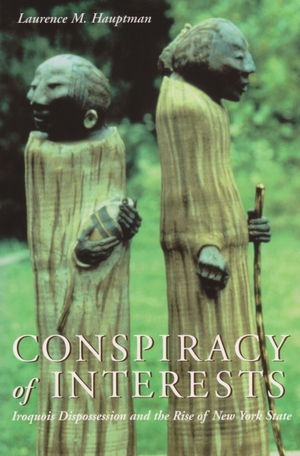BookNotes- Conspiracy of Interests by Laurence Hauptman

Conspiracy of Interests: Iroquois Dispossession and the Rise of New York State.
by
Laurence Hauptman
Finished 3/29/21
A rich and detailed history of how the Iroquois/Haudenosaunee people, who had controlled almost all of what became New York State prior to the Revolutionary War, lost almost all of it to American speculators, politicians and colonizers.
At their political and cultural height (particularly in the 17th century), it is likely that the Haudenosaunee confederacy (sometimes called the Iroquois) occupied almost the entirety of what became New York state, as well as Southern Ontario and swaths of the Mid-Atlantic. And certainly their cultural influence colored and structured much of Eastern North America and directly impacted the arrival and spread of Europeans to the Continent. By the the time of the American Civil War, they had been reduced to half a dozen reservations scattered across New York, and with other communites removed to Wisconsin.
Hauptman is one of the best White historians of the Iroquois, and this book is his attempt to situate and understand how Iroquoia became New York. To that end, he focuses particular attention on the dispossession of the Oneida Nation and the Seneca Nation, two of the Nations that make up the Six-Nations Haudenosaunee Confederacy (the others being the Cayuga, Mohawk, Onondaga, and Tuscorora).
There’s a lot of astonishing detail in here, but a few overall themes emerged that really stuck with me. The first is that when we think of the process of colonization, we tend to think of land as the benchmark measure of loss and gain. But what Hauptman makes clear is that the infrastructure that connects a landscape together, in this case canals, turnpikes, and roads, are the actual engines of colonialism. Thus, the industrial corridor of New York, including the cities of Buffalo, Rochester, Syracuse, and Utica, came together through the building of such infrastructure, and this occurred alongside and because of the dispossession of Oneida and Seneca lands. The architects of this stitching together of central and western New york were all land speculators and their political allies (including Philip Schuyler, father-in-law of Alexander Hamilton) who understood that they couldn’t really drive the Haudenosaunee out unless there was a mechanism to transport people and goods into their lands.
The second theme was the interrelationship of economic, political, and cultural forces arrayed against the Haudenosaunee in their struggle to maintain their land. Characters like Schuyler were politicians, land-speculators, Native brokers throughout the course of their lives, and their connections with each other cemented the “conspiracy” from which the book’s title comes. In many cases, the treaties and land sessions made with the Oneida and Seneca were not legal at the time, or were conducted under coercion or false pretenses or playing internal Indigenous factions against each other, but the momentum of settlement that followed them obviated their “legality” and replaced it with force. To take an obvious example, New York State had no legal authority to make a treaty with another sovereign nation, and yet, various land sessions between the Oneida and New York state were functionally “treaties” in which the Oneida ceded land in exchange for protection, and which ultimately worked to the benefit of land speculators and improvers who then used New York’s ownership as a pretense for White expansion. This is particularly tragic, given that the Oneida had fought alongside the Americans during the Revolution, creating the very country that then overwhelmed them.
Functionally, New York state was not a cohesive or coherent state until it was stitched together with Infrastructure, and this stitching was done at the expense of the Haudenosaunee peoples who lived there. The long legal history of (particularly Oneida) land claims in New York in the 20th century is a fallout from the greed and dubious legality of the White actions described in this book. It’s a fascinating and angering history that anyone who calls New York State home should read and understand.
